
Osteocephalus is a genus of frogs, the slender-legged tree frogs, in the family Hylidae found in the Guianas, the Amazon Basin, Venezuela, Colombia, southeastern Brazil, and north-eastern Argentina. Males are warty, while females are smooth.

Rhinella poeppigii is a species of toad in the family Bufonidae that is known from the eastern Andean slopes of Ecuador, Peru, and Bolivia, as well as from Serranía de Sira in Amazonian Peru. Its distinctiveness from Rhinella marina has been debated, but it is currently accepted as a valid species. It is named after Eduard Friedrich Poeppig, German botanist and naturalist who made scientific expeditions to South America.
Hyloxalus awa is a species of frog in the family Dendrobatidae. It is endemic to Ecuador and known from the western Andean slopes and the western Pacific lowlands.
Hyloxalus elachyhistus is a species of frog in the family Dendrobatidae. It is found in southern Ecuador and northern Peru, in the Huancabamba Depression and south to Cajabamba Province.
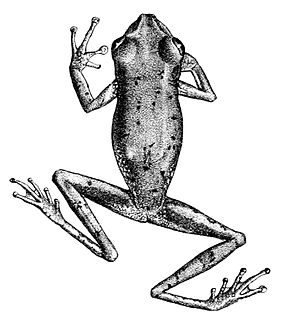
The whitebelly tree frog is a species of frog in the family Hylidae found in Ecuador and possibly Colombia and Peru. Its natural habitats are tropical and subtropical moist lowland forests, swamps, intermittent freshwater marshes, plantations, rural gardens, and heavily degraded former forests. It is threatened by habitat loss.

Osteocephalus helenae is a species of frog in the family Hylidae. It is widely distributed in the Amazon Basin and is known from the lowlands of Bolivia, Peru, Brazil, Colombia, Venezuela, Guyana, and French Guiana. The specific name helenae honors Helen Beulah Thompson Gaige, an American herpetologist. Common name Helena's [sic] treefrog has been proposed for it.

Hyloscirtus tapichalaca is a species of frog in the family Hylidae. It is endemic to Ecuador and only known from the vicinity of its type locality in the Tapichalaca Biological Reserve, Zamora-Chinchipe Province. It is named after the type locality, which is a reserve owned by the Fundación de Conservación Jocotoco. Hyloscirtus tapichalaca belongs to the Hyloscirtus larinopygion group, although its placement with the group is uncertain; it may be the sister taxon of all other species in the group.

Osteocephalus buckleyi, also known as Buckley's slender-legged treefrog, is a species of frog in the family Hylidae. It is found along the periphery of the Amazon Basin in Bolivia, Peru, Ecuador, Colombia, northeastern Brazil, Venezuela, Guyana, Suriname, and French Guiana, and also in the Orinoco Delta in Venezuela. It is probably a species complex. Some sources treat Osteocephalus vilmae from Ecuador and Peru as a valid species.
Osteocephalus cabrerai is a species of frog in the family Hylidae. It is found in the Amazon Basin in Brazil (Manaus), northeastern Peru, Ecuador, Colombia, Guyana, and French Guiana, possibly wider. Some earlier records refer to Osteocephalus buckleyi.
Osteocephalus deridens is a species of frog in the family Hylidae. It is found in the Napo and Pastaza River drainages in eastern Ecuador and in the Loreto Region, northern Peru. The specific name deridens is derived from Latin deridere, meaning "make fun of someone". This alludes to the males calling from the treetops that sound "as if they are laughing at the collectors' vain attempts to reach them". Common name funny slender-legged treefrog has been coined for this species.
Osteocephalus fuscifacies is a species of frog in the family Hylidae endemic to Ecuador. It is known from the Napo River drainage at intermediate elevations. The specific name fuscifacies is derived from Latin fuscus (=tan) and facies (=face), in reference to the uniform tan-colored loreal region and the lack of a light subocular spot. Common name Napo slender-legged treefrog has been coined for this species.
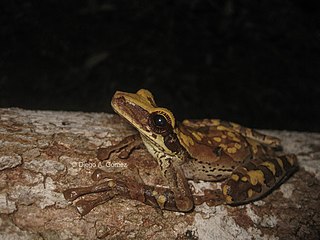
Osteocephalus planiceps is a species of frog in the family Hylidae found in Colombia, Ecuador, Peru, and possibly Brazil. Its natural habitat is subtropical or tropical moist lowland forests. It is threatened by habitat loss.
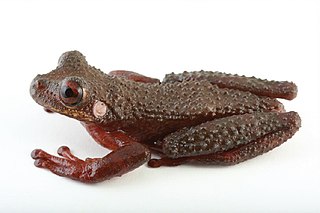
The Ecuador slender-legged tree frog is a species of frog in the family Hylidae found in Colombia and Ecuador. Its natural habitats are subtropical or tropical moist lowland forests, subtropical or tropical moist montane forests, rivers, intermittent freshwater marshes, rural gardens, and heavily degraded former forests.
Osteocephalus yasuni is a species of frogs in the family Hylidae. It is found in the upper Amazon Basin in southern Colombia, Ecuador, and northeastern Peru at elevations of 70–250 m (230–820 ft) above sea level. The specific name yasuni refers to the Yasuni National Park where its type locality is.

Scinax elaeochroa, commonly known as the Sipurio snouted treefrog, or olive snouted treefrog, is a species of frog in the family Hylidae. It is found in the Caribbean lowlands of Nicaragua and Panama and in the Pacific lowlands of Costa Rica and Panama, with an isolated population in Colombia.
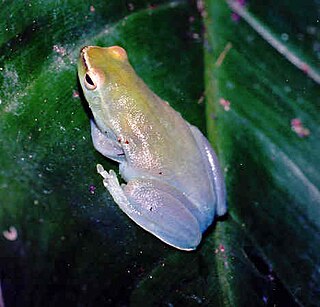
Sphaenorhynchus lacteus, the Orinoco lime treefrog or greater hatchet-faced treefrog, is a species of frog in the family Hylidae. It is a widely distributed species found in the Orinoco and Amazon basins in Venezuela, the Guianas, Colombia, Brazil, Ecuador, Peru, and Bolivia. It also occurs in Trinidad and Tobago.
Pristimantis pseudoacuminatus is a species of frog in the family Craugastoridae. It is found in the Amazon basin in Colombia, Ecuador, and Peru. Common name Sarayacu robber frog has been coined for it.
Noblella myrmecoides is a species of frog in the family Craugastoridae. It is found in the upper Amazon Basin of southeastern Colombia, eastern Ecuador, eastern Peru, Bolivia, and western Brazil (Amazonas). Common name Loreto leaf frog has been coined for this species.
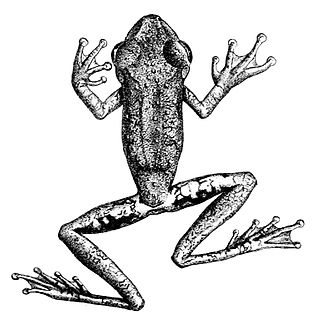
Dryaderces is a small genus of frogs in the family Hylidae. Their known distribution is disjunct, with one species found in the upper Amazon Basin and lower Andean slopes between central Peru and Amazonian Bolivia, and another one in Pará, Brazil. Its sister taxon is Osteocephalus. No phenotypic synapomorphies defining the genus are known.
Osteocephalus castaneicola is a species of frog in the family Hylidae. It is found in lowland Amazonia of northern Bolivia, adjacent southeastern Peru, and western Brazil. It breeds in water-filled fruit capsules of the Brazil nut, a characteristic also alluded to in its specific name castaneicola derived from the Latin castanea, the root of the vernacular name castaña for the Brazil nut, together with the Latin colō meaning "to inhabit".











